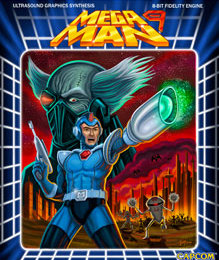328th played so far
 Genre: Platform/Action
Genre: Platform/Action
Platform: Playstation 3/XBox 360/Wii
Year of Release: 2009
Developer: Capcom
Publisher: Capcom
After the release of the list’s second edition, 20 games were removed, with twelve of them unplayed so far. For completeness and because we waned to try some of them, we decided to still play these twelve, but with shorter or changed write-ups. Today the first of these – a look not just at the ninth Mega Man game, but a chance to discuss the series as a whole.
As major a franchise as Mega Man is – over 50 games created, one of Capcom’s biggest, most prolific franchises – it is still mostly ignored by the list. Only one game is listed, and that’s the fanbase focused Mega Man 9, the game that’s officially on the list. While it’s probably meant to be one game to represent the series as a whole, going for the retro-looking, updated but probably lesser known ninth (download-only) version of the game seems like an odd pick. Sure, it’s technologically better, but does it really shine in comparison with Mega Man 2, probably the first real classic in the series (and the one I grew up with), or Mega Man 4, where the series really hits its stride, introducing the final defining gameplay elements?
Yes, sure, the games all have a lot in common – an early example of reusing and extending the game engine for multiple sequels – but that would be more of an argument to go for a classic game.
Why is this such a beloved franchise then? Well, part of the nostalgia probably comes from its difficulty. The games are incredibly unforgiving with no save points, continues that usually dump you back at the start of the level and careful precision required in many parts of the game. Enemies are common, awkwardly placed (for you) and respawning if you scroll the screen a few pixels too far or wait a bit too long.
But when you can do it, it feels like it pays off. Not just in progressing in the level, but to get to the bigger areas. The boss fights really pay off, with each of the initial eight (or sometimes six) robot masters providing a challenge. They each have their own fighting style, but are even more important as the reward you get as you defeat them. From time stoppers to shields to all different sorts of attacks, getting them and being able to use them just feels amazing. It makes the subsequent levels easier as well – the gathered weapons tend to be stronger than your default, or else add some other advantage that makes the level easier – even down to being able to reach more secrets.
Another part of this is the level design. As said, each robot master has their own level, all themed to the robot master’s name and weapons (although these are more similar between games – pretty much all the fire-based robot masters have lava levels, often with similar disappearing blocks). Half the fun jumping into Mega Man 9 – the first time I played it – was trying all eight available levels and seeing what each offered – and how much more difficult the games feels (or, probably, how much less competent I am from not having the muscle memory for these levels, compared to what I had for Mega Man 2 – the game I started with, and the favourite).
The combination of these two works out to a group of engaging games, with the different iterations on the game creating an enjoyable experience. Unfortunately, it was one that (for the classic series) became less relevant after the NES era, with the sequel series becoming more prominent. The Mega Man X series is the original example, taking the basic gameplay, refining it with a number of new features (such as wall jumping) and allowing for a more polished release on the (then) next-gen SNES. This, again, was followed by sequels until the PS2 era, creating a more story-based longer running series with a lot more going on than Mega Man‘s simple ‘kill the robots and capture Wily’ storyline. (Although to be honest, the simplicity was charming, and made for something far more straight forward). This, too, got its spinoffs in the Mega Man Zero series, taking the games a further step away from the original.
There’s plenty of other spin-offs as well – the action RPG Mega Man Battle Network series (and its Star Force spin-off) placed the game a step further in a different genre that (despite some story issues) tended to create pretty decent gameplay. Then there’s the one-time games, featuring Mega Man characters playing soccer or fighting in a beat ’em up setting.
But despite all of that, the simplicity of story and concept of the original series is the most engaging for me, and the one that deserved its followups that were officially covered in the book. It has the solid gameplay that slowly grows as you play through the game, with some difficulty that, given the time, feels like a true test of skill, and makes you feel like a master when you get that far.
And one day I will defeat that dragon and make it further into Mega Man 2. I know I will.
[…] is only represented by a single game on the list and an odd one at that. It’s a bit like the Mega Man series – even if the latter’s example follows the standard games more […]
[…] Mega Man 9 is one of the latest iterations of a major franchise that I never played until this year. It’s […]